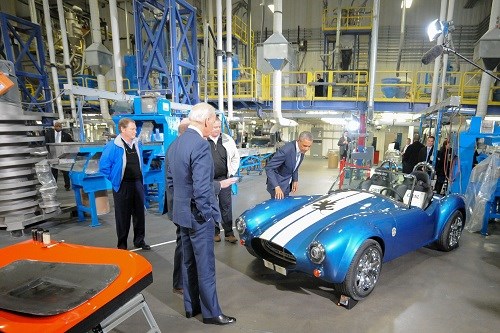Mfg. Innovation Hub To Strengthen U.S. Leadership In Next-Gen Composites
Techmer is part of a new consortium to advance country's position in next-generation composite materials; first 3D-printed electric car unveiled.
Last Friday, President Obama and Vice President Biden visited the Clinton, Tenn.-based manufacturing site, and after touring a portion of the facility, the President made a major announcement about the creation of a $250-million manufacturing innovation hub aimed at strengthening U.S. leadership in next-generation composite materials.
The Knoxville, Tenn.-based Institute for Advanced Composites Manufacturing Innovation (IACMI) is a consortium of the Department of Energy (DOE) and 122 company partners and members, including Techmer ES (Engineered Solutions), a wholly-owned subsidiary of Techmer PM.
IACMI, which is part of a larger plan to boost manufacturing, foster innovation, and create jobs for the middle class, will focus on cutting-edge research on advanced composites, such as carbon fiber compounds, which Techmer ES has developed. This composite was recently used to bring to life an additive manufacturing (or, 3D printing) project with Oak Ridge National Laboratory (ORNL).
“Our successful work with Oak Ridge National Laboratory was the genesis for the President’s visit and a prime example of composite materials advances achieved through a transformative technical partnership,” said chairman and CEO of Techmer PM John Manuck. Techmer ES partnered with ORNL, contributing its high-performance materials expertise to help the DOE laboratory develop a large-scale additive manufacturing system. Techmer ES created a unique carbon fiber-based thermoplastic formula to help further ORNL’s progress in building an additive manufacturing system that is 200 to 500 times faster and can print components ten times large than what was previously possible. This is the BAAM (Big Area Additive Manufacturing) machine, developed by ORNL and Cincinnati Inc., that was used to produce the “Strati”, the world’s first 3D-printed car that was designed by Local Motors and made its debut at IMTS 2014. It extrudes hot thermoplastic to build parts layer-by-layer, similar to an FDM machine.
Following a further upgrade to BAAM, ORNL and Techmer ES developed the first full-size 3D printed electric car. The fully-functioning Shelby Cobra 289 FIA was unveiled during last Friday’s tour. The 1400-lb vehicle contains 500 lbs of 3D printed parts (the body of the vehicle) made from Electrafil J-1200/CF/20, a 20% carbon-fiber-reinforced ABS formulated by Techmer ES. The material was also used for the tooling, according to Tom Drye, managing director of Techmer PM, “From a new carbon fiber technology to the exciting frontier of large-part additive manufacturing—3D printing—our working relationship with the National Lab has been a model of cooperation and innovation,” he said.
The vehicle is now at the North American International Auto Show in Detroit—Jan. 12-25.
Want to find or compare materials data for different resins, grades, or suppliers? Check out Plastic Technology’s Plaspec Global materials database.

Related Content
-
Advanced Biobased Materials Company PlantSwitch Gets Support for Commercialization
With participation from venture investment firm NexPoint Capital, PlantSwitch closes it $8M bridge financing round.
-
How to Optimize Injection Molding of PHA and PHA/PLA Blends
Here are processing guidelines aimed at both getting the PHA resin into the process without degrading it, and reducing residence time at melt temperatures.
-
Polymer Science for Those Who Work With Plastics: Molecular Weight — What It Is and Why It Matters
Molecular weight might seem like an abstract concept, but it plays a crucial role in determining the behavior of plastics during processing and in their final applications.






